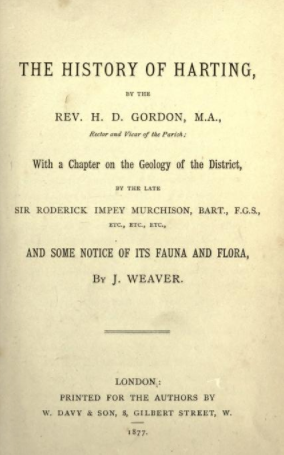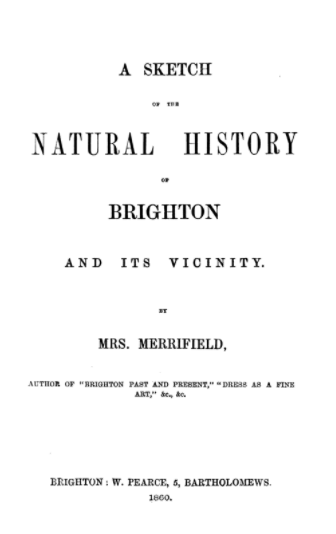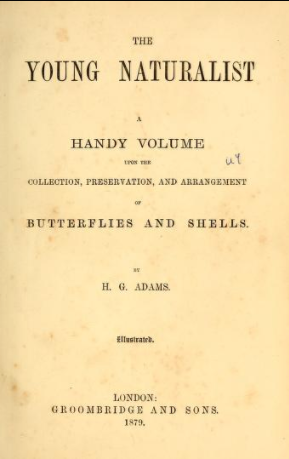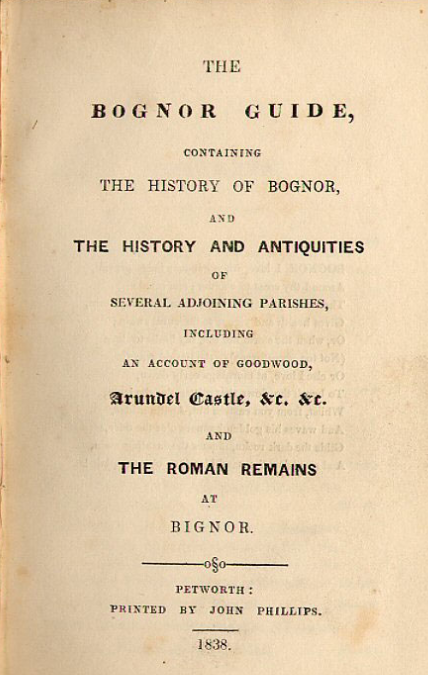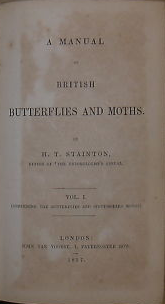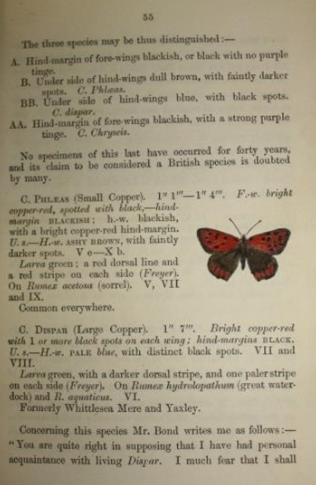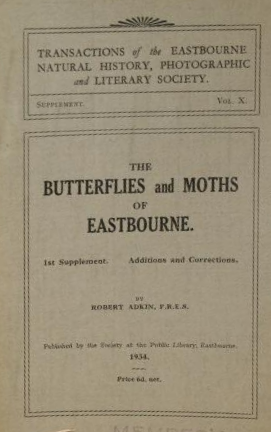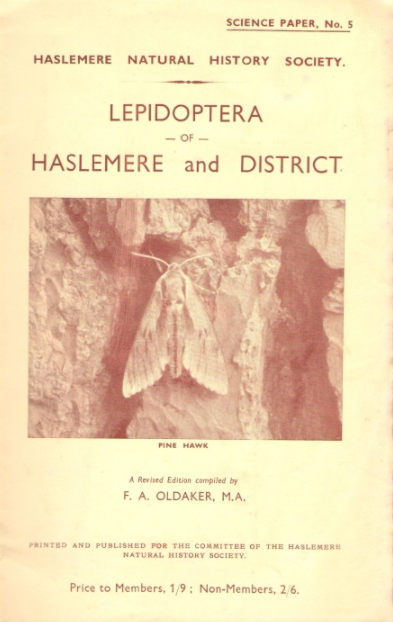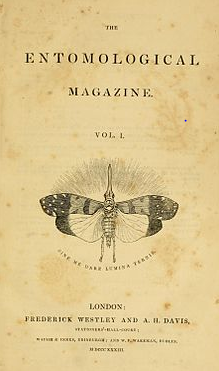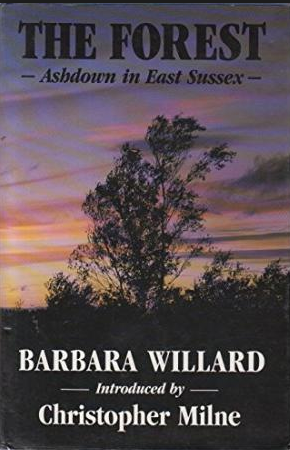The History of Butterfly Recording in Sussex
Extracted from
"A COMPLETE HISTORY OF THE BUTTERFLIES AND MOTHS
OF SUSSEX"
written and published in 2011 by Colin R. Pratt
PRIMARY PUBLISHED SOURCES OF INFORMATION, BY AREA
To give future researchers an advantage, the following directory contains the most comprehensive sources of information on the Sussex lepidoptera and details all of the significant lists published for each district and where they can be found within the literature. There have been dozens of lesser works scattered throughout entomological journals since the second quarter of the 19th century. These have been listed individually within the main text and in the references. Most of the information offered in these earlier works is accurate but a few reports are less so. For example, E. Heron-Allen recorded 25 species of butterfly and 22 macro-moths at Selsey (Heron-Allen, 1911) - but the work is contaminated with such glaring errors that it is virtually worthless.
ALL SUSSEX
One of the misfortunes within the history of our lepidoptera recording was that the great felt unable to complete a county list. After twenty years work gathering records, he "finally decided only to be interested in my own captures & those of my friends for I found that nearly all the interesting species I was given information about, when traced back to source & probed into, proved not to have been taken in Sussex at all or to be questionably so taken" (Wightman, mans.). In my view this was an error of judgment.
Our pioneering recorders worked Sussex during the 1840's and 1850's. But the first suggestion that county-wide catalogues of flora and fauna should be compiled came from on March 18th 1873 at a meeting of the Brighton Natural History Society. Whilst there was initial enthusiasm, two years later the results of the project were "almost nil". Nevertheless, by the end of that century a vast amount of knowledge had been accumulated, much having been published meanwhile in local lists. All of this work paved the way for the first all-Sussex collation.
Published in 1905 within volume 1 of the "Victoria History of the County of Sussex", the butterfly section was compiled by and occupies pages 164 to 170; 61 butterflies are mentioned. Similarly, the moth portion was edited by , 620 macros being listed from page 170 to 190 and 913 micro-moths from 190 to 210. The work is thorough but some misconceptions and inaccuracies are upheld - haworthii, aquilina, conspicillaris, scrophulariae, paralellaria, cognata, tristata, and populata, within the macros - and one or two important records ignored. This account contains much vital and informative annotation in narrative form, this including mention of many localities, but the macro-lepidoptera section is basically that of the mid 1880's - 's eastern list together with additions from western compilations by (see below), and of a relatively few privately-communicated records from . Therefore, by 1905 much of this grand work was twenty years out of date.
The list of micro-lepidoptera which followed these pages remains the only early county-wide reference with any detail up until now, although it does boast Fletcher's expertise - and he was a national authority on the subject. A simple catalogue of the micros was also compiled and made publicly available in 2005 by , although this was based on polluted records which had been anonymously identified and sourced.
After general interest in natural history had waned during the early years of the new century, only a hard core of enthusiasts continued to work during following decades. Nevertheless, they produced two summaries of additions. The "Additions to the Lepidopterous Fauna of the County of Sussex since the Publication of the Victoria History List, 1905", was issued in 1932 by within pages 28 to 33 of the "Entomologist". This survey gathered together all of the records of 21 species of macro-moth new to the county since 1905, reviewed 17 others, and also encompassed the changing status of 11 butterflies. Another update was made by in 1956, on pages 89 to 91 of the "Entomologist's Gazette", this being entitled "Additions to the Macrolepidopterous Fauna of Sussex since 1932". Here Haggett noted another 22 species fresh to Sussex since that year.
After many years of neglect, during the 1970's there was a revival in interest across the county which enabled a second complete review of Sussex butterflies and macro-moths to be made in 1981 (Pratt, 1981).
In addition to information in the literature, the Booth Museum of Natural History holds a number of collections which contain early specimens taken in various parts of Sussex. The general collection, including that of E. Webster which is frustratingly labeled with code numbers, dates from the late 19th century to the present day; the G. Botwright collection dates from 1910 to 1993; the R. Dumbrell accumulation dates from 1963 to 1977; and the A. E. Tonge collection dates from throughout the first third of the 20th century.
Other museums also hold Sussex material; Tunbridge Wells Museum retains the T. Blest collection of lepidoptera, dating from the late 19th century to 1948; the R. Long collection can be found in Haslemere Museum, this dating from 1930 to 1964; D. A. Odd's entomological diaries, dating from 1949 to 1969, are in Leicester Museum while his collection is held at Worthing Museum; an accumulation formed by J. H. B. Lowe exists at the Ashdown Forest Centre near Wych Cross; Littlehampton Museum exhibits a lepidoptera collection dating from 1909 to 1949, this including specimens captured by C. D. Ash and H. C. Jeddere-Fisher; and Haslemere Museum has a general lepidoptera collection dating from the late 19th century to the 1930's, including specimens captured by Richards, E. P. Sharpe, Worsley-Wood, and others. 's entomological diaries which date from 1898 to 1929 have also been recently discovered by English Nature at Peterborough.
The first large-scale distribution maps (to a sensitivity of a 2 kilometre square) to be produced came in 1980, when the West Sussex Wildlife Recording Group distributed a series of 42 accurately compiled maps of the butterflies found in their half of the county. No dates were mentioned but all records seem to have been made during the 1970's. A number of the more interesting distribution maps of both butterflies and moths were then included in the second complete survey of the county, published in 1981 (Pratt, 1981).
A complete set of distribution maps of the county's macro-lepidoptera was privately produced, this being collated and drawn by and edited by ; the coverage was comprehensive and accurate. Then, from 1989 onwards, the Sussex branch of the Butterfly Conservation sponsored more maps, this time an annual survey initially for five years just of the butterflies. The aim of these enthusiasts was to compile the most comprehensive distribution maps of our county's butterflies ever produced but unfortunately part of this potential was thrown away.
Maps of the common species were published which certainly exhibited a coverage in excess of any of those produced before - but unnecessary self-imposed secrecy resulted in the retention of what were ill-considered to be the more important maps, which crippled the result. However, the society kindly allowed the addition of their distribution maps of common species to be added to my own for inclusion within another review of the Sussex butterflies, macro-moths, pyralids, and plumes, this time on a CD in 1999 (, 1999). All due acknowledgement is hereby given to the contribution that these hard-working enthusiasts have made to our knowledge of the status of these particular butterflies, both for that project and for this work.
The number of recorders of all groups then multiplied during the 21st century, this enabling these current volumes to be collated.
ARUNDEL
In 1930 published a list of macro-lepidoptera from the Arundel area within 's "Waters of Arun", pages 162 to 164. This worked covered 14 butterflies and 165 macro-moths, two of which were errors - scropulariae and dilutaria. Two years later Jeddere-Fisher produced a much improved version of the work with the assistance of , entitled a "List of Lepidoptera taken in Littlehampton and District". This was produced in the "Natural Science and Archaeological Society: Reports of Proceedings, 1931 - 1932", pages 13 to 20. Only one error was included - scrophulariae. The compilation encompassed the status of 41 butterflies and 382 accurately determined macro-moths but was also "known to be very incomplete".
From late November 1945 to late 1947 noted all of the macro-moths seen at a tungsten bulb in a moth trap run nightly at his home on Torton Hill. This resulted in two faultless lists, both of which were published in the "Entomologist"; in 1947, pages 97 to 101, and in 1948, pages 30 to 34. The earliest collation recorded 235 moths and the second 247.
BOGNOR
compiled several catalogues of the lepidoptera seen and collected at Bognor during the 1880's - and "every one of the specimens was captured in the grounds of the "Dome", his home. The first was of those insects seen during the year of 1881, this being published in the "Transactions of the Chichester and West Sussex Natural History and Microscopical Society" during the following year. A dozen butterflies and 88 species of macro-moths were noted. In 1882 Lloyd added two more butterflies and 26 moths to his list, this work being published in the same magazine in 1883.
In 1887 he wrote a revue of his entomological experiences at Bognor in "The Young Naturalist", volume 8, pages 205 to 208, but his best efforts came a little later. In 1889 Lloyd collated the results of a decade's work at Bognor, listing 20 butterflies and 209 macro-moths together with their status in the "Transactions of the Chichester and West Sussex Natural History & Microscopical Society", pages 63 to 77.
His last and most extensive work was published as an appendix to Webster & Webb's "Bognor Guide" in 1891, within a section entitled "Complete Lists of Plants, Seaweeds, Lepidoptera, Crustacea and Mollusca, to be found in Bognor & Neighbourhood". Here he added another six moths to his list of 1889 and removed one error (adusta). Micro-lepidoptera were included in these last two reports. Lloyd therefore accurately accumulated local records of 20 butterflies and 214 macro-moths at Bognor during 11 years work.
BRIGHTON
The Booth Museum of Natural History hold the important diaries of Henry Cooke, which date from 1848 to 1857. This manuscript contains a wealth of information on the early days of Lepidoptera collecting near Brighton. then published the two volumes of his "Manual" in 1857 and 1859. Within these books an unidentified Brighton reporter noted the status of 43 species of butterfly and 378 macro-moths, although there were three errors (versicolora, aquilina, and populata). Stainton's informants may well have been and/or . In any event, within a year Cooke, Winter, and other local collectors, contributed to a more extensive inventory within "Sketch of the Natural History of Brighton", which was completed early in 1860. 48 species of butterfly, 476 macro-moths - just two of which were understandably in error (populata and aquilina) - and 495 micro's were mentioned in this magnificent effort,
CLIMPING
In 1992 a report from the Clymping Gap Preservation and Field Recording Society listed 25 butterflies from this part of the coast. One, H. comma, was an error. Compiled by , the report also lists 234 macromoths. Here there are two misjudgements - muricata and plagiata - and another, inturbata, requires confirmation.
EASTBOURNE
The first local list was compiled by members of the Eastbourne Natural History Society from 1867 to 1873 and was published in "A Handbook for Eastbourne, Seaford... and the Neighbourhood" by . The guide was published in 25 editions from 1868 to 1901 and most, but not all, contain this list of 45 species of butterfly and 62 macro-moths. Many additions to this catalogue were then made by at Abbot's Wood, the aggregate of these sightings being published during the mid 1880's in 's East Sussex list and in 1905 in the Victoria County History. About a quarter of a century later an extensive survey of the lepidoptera of the area was made by , this being published within the "Transactions of the Eastbourne Natural History, Photographic and Literary Society".
The section referring to butterflies arrived in 1928, as a supplement to volume 9; the moths came in two parts, also as supplements, this time to volumes 10 and 11, in 1930 and 1931. A list of additions and corrections was issued in 1934. Adkin reported positive details of 50 butterflies and 492 macro-moths, as well as all of the region's micro's. This well produced and illustrated work was the finest of the local lists.
In 1949 wrote a fresh review of the butterflies in the Eastbourne district. This was published in part 1 of volume 13 of "The Journal and Transactions of the Eastbourne Natural History Society" for that year, pages 12 to 16. The list was informative and accurate. At this time D. Hillman and D. Saunders started to collect lepidoptera in the Eastbourne district.
Their collections survive in the Booth Museum of Natural History, 's dating from 1949 to 1955 and from 1953 to 1976. executed another review in 1977, this time of the macro-moths, in the "Entomologist's Record and Journal of Variation", pages 36 to 38, entitled "The MacroLepidoptera of Eastbourne (Excluding Butterflies)". This summary of local change was accompanied by the addition of 11 new species.
EAST SUSSEX
In 1886 published his "Macro Lepidoptera of East Sussex" within volume 1, part 10, of the "Transactions of the Eastbourne Natural History and Archaeological Society" pages 61 to 82. Planned from the early 1870's onwards, this well-informed and unequalled work summarised all that was known about the vice-county's butterflies and moths up until publication. The directory enumerated 56 species of butterfly and 578 macro-moths together with their localities and status. Jenner's collection still survives, together with a large number of manuscripts and diaries dating from 1863 to 1873, all being held by the Booth Museum of Natural History.
The collection of many eastern Lycaenid butterfly varieties made by A. E. Stafford from 1924 to 1971 is also held by the Booth Museum. Another more general collection, made in this area by H. D. Peile from 1925 to 1971, is retained by Bexhill Museum.
EBERNOE COMMON
A list of 93 different macro-moths, 34 butterflies, 23 Pyralids, and two Plume moths, was collated from Ebernoe Common by from data obtained between 1981 to 1991 inclusive (Syms & Syms, 2000). The lepidoptera contained on these short lists were generally accurately identified - all of those so determined by R. Fairclough being correct - but the inclusion of E. dilutata needs confirmation by a microscopic examination of genitalia, and that of the Pyralid C. pratella is considered here to be erroneous. The estimates of butterfly frequency are far less safe, most being gross exaggerations.
HARTING
Edited by the , in 1877 "The History of Harting" was published. Within the informative and annotated narrative, on pages 389 to 419 a revealing chapter written by enumerated 37 butterflies and 97 moths to be found in the district. A few of the micro-lepidoptera were also included.
HASTINGS
In 1878 a booklet was published by the Hastings Natural History Society, price 1/6d, entitled "The Natural History of Hastings and St. Leonards and the vicinity". Within this volume, pages 24 to 29, the published a fine account of both the macro and micro-lepidoptera to be found in the far east of Sussex. This collation contained 44 species of butterfly, 442 macro-moths, and many more micros. From work performed in 1879 and 1880, W. Bennett and S. Hume added seven more macro-moths to the Hastings catalogue in an article in "The Young Naturalist" of 1881, volume 2, pages 141 to 141.
These additions were incorporated in the first of three supplemental lists made by Bloomfield to his original work, which came in 1883, when 16 moths were added. In 1888 the second extension appeared, by which time another 12 moths had been discovered and two queried, and in 1897 the last was brought forward when one butterfly and 16 more macros were mentioned. Bloomfield and more than a dozen listed local collectors therefore positively reported 45 species of butterfly and 486 macro-moths from the Hastings district, of which just two were errors (haworthii and valligera). The 1878 compilation does not disclose exact localities. However, Bloomfield's personal copy of his own list still survives, in Hastings Museum, and here his hand-written annotations reveal all. A short anonymous list of local butterfly records dating from 1912 to 1933 is also held by Hastings Museum.
With a little assistance from N. F. Ticehurst and some foundation work on the butterfly section by J. M. Baines, almost three-quarters of a century after Bloomfield's review, wrote a comprehensive retrospective of the districts macro-lepidoptera. This work contains estimates of each insect's frequency and details some localities, it being published in the "Hastings and East Sussex Naturalist" starting in 1951. The first part was entitled "A Survey of the Rhopalocera of the Hastings District" and can be found in volume 7, part 6, pages 209 to 224. The variously titled review of the macro-moths was published from 1952 to 1957 inclusive, in volume 8; in part 1, pages 3 to 9; in part 2, pages 51 to 58; part 3, pages 79 to 88; part 4, pages 125 to 135; part 5, pages 158 to 168; and in part 6, pages 191 to 199. Mowbray reported on 54 butterflies, two of which can be deleted; one was an identification error (argus) and another had only been seen in nearby Kent. Similarly he noted 562 macro-moths, four of which were incorrect (viridata, "strigaria", olivata, and haworthii) and two of which had only been found in Kent.
HAYWARDS HEATH
The only source of any quantity of early information from this area came from the during the 19th century. He collated several unpublished lists which were included in 's eastern inventory of 1886.
HORSHAM
The Horsham area has been well served by its recorders. and noted a large number of lepidoptera at Tilgate Forest in about the 1870's and 1880's, these being reported within 's eastern list of 1886. But catalogued most of the macro-lepidoptera to be found near Horsham during the late 19th century - 41 butterflies and 442 macro-moths. This work, irregularly annotated with localities and each species status, can be found in his "The History and Antiquities of Horsham" published in 1889, pages 233 to 250. With two exceptions (tristata and conspicillaris), his important revue is considered accurate.
was responsible for the collation of a long series of annual reports on lepidoptera found by his schoolboys within five miles of Christ's Hospital from 1903 to 1927 inclusive. Regular summary lists were also published, in 1903, 1905, 1910, 1919, and 1927. Many dated records are quoted along with some localities. After a couple of selfcorrected errors, the catalogues became a very accurate and important record. Within a quarter of a century White and his young assistants had set a fine example for modern schools, having logged 37 species of butterfly and 472 macro-moths. Some micro-lepidoptera were also included in these reports. Succeeding pupils wrote some later annual summaries but they were of comparatively little value.
made an inventory of all of the macro-moths encountered at an mv moth trap situated in the game warden's garden in St Leonard's Forest in 1962. Long listed 284 species, of which three are believed to be errors (dysodea, ternata, and populata). The work was embodied in "The Natural History of St Leonard's Forest", edited by and published by the Horsham Natural History Society in 1983. An incomplete list of 23 species of butterfly was also included, this being compiled by J. Syms. And most recently, the warden of Warham local nature reserve, S. Bayley, compiled significant annual lists of sightings from 2004 to 2009, these being published by Horsham District Council.
KINGLEY VALE
An amalgamation of work performed by , was listed in the back of a book written by Williamson and entitled "The Great Yew Forest". Published in 1978, the list encompasses 33 butterflies and just 104 moths.
LEWES
The earliest dated Lewes records are contained in the diary of . This manuscript is retained by the Booth Museum of Natural History and dates from 1857 to 1859. At the middle of the 19th century an anonymous contributor to 's "Manual", published in 1857 and 1859, forwarded a list of lepidoptera from Lewes. A catalogue of 383 species of macro-moths and 44 butterflies was enumerated, this including two understandable errors (stramineola and aquilina). The unidentified recorder may have been Blaker.
The only later published lists which contain any comprehensive reference to the lepidoptera of the Lewes area are those based on the work of , who was assisted by , , , , and . Jenner's magnificent contributions are contained in his eastern catalogue of 1886 and more anonymously within the Victoria County History of Sussex of 1905. The Booth Museum of Natural History holds an informative diary of butterfly records from all around the Lewes district written by from 1906 to 1945. And in recent times a survey of the moths at Glynde was carried out in 1982 by , this being written up as part of a submission for an M. Sc. at the Brighton Centre for Advanced Biology.
MIDHURST
listed 30 butterflies to be seen near Fitzhall at the very middle of the 19th century. The frequency of each insect is noted, along with some coded descriptions of localities. This was published in 's Naturalist for 1852, volume 2, pages 226 - 229.
THE NORTH-EAST
was the only lepidopterist to gather and publish any number of records from this area up until modern times. Particulars of the inaugural survey are contained within "Tunbridge Wells and Neighbourhood", edited by and published in 1916. An updated list is provided by Morgan in "Royal Tunbridge Wells, Past and Present", edited by and published in 1946. Even more importantly, he left a manuscript entitled the "Lepidoptera of the Tunbridge Wells District" with the local museum, which details all of the records, localities, and then current status on which these two catalogues were based.
A few additions to the manuscript were also made during the 1950's by . Morgan's work brought together records from within a 12 mile radius of Tunbridge Wells and features 51 species of butterfly, 410 of macro-moths, and some micros. However, his correspondents did make a few considered errors (including leucophaea, menyanthidis, reticulata, petasitis, and littoralis).
In 1989 with some overstated status claims, including one "probably overlooked", and a short list of 63 macro-moths. This was published in an appendix to's "The Forest. Ashdown in East Sussex".
THE NORTH-WEST
"A List of the Lepidoptera occurring within Six Miles of Haslemere" was published by in 1913, the area under survey including a significant portion of north-west Sussex. This accurate compilation of 46 butterflies, 474 moths, many micro's, and their status, was followed by a supplement in 1920 by which added a few more Surrey records. In 1951 Oldaker issued another list under the same title, which was almost the same as the first. This was largely 40 years out of date. A few annotated additions were made to a copy of this list held by Haslemere Museum in 1973 by .
STORRINGTON
In 1934 published a catalogue entitled "The Geometers of Storrington, W. Sussex" in the "Entomologist's Record and Journal of Variation", pages 15 to 16, 64, 107, and 129. Robertson reported on the current status of 160 species from within a five mile radius of the village. With just one suspect record (paralellaria), the work was very accurate.
WESMESTON
In 1925 published his "Round About Sussex Downs". Here Wood accurately lists 38 local butterflies and 287 macro-moths from the Westmeston/Ditchling/Plumpton area.
WEST SUSSEX
The first effort to compose a list of western lepidoptera was made in 1886 by W. in the "Transactions of the Chichester and West Sussex Natural History and Microscopical Society", pages 59 to 81. Here Fletcher positively reported 35 butterflies, 210 macro-moths, and many micro's, in a largely personal inventory made mainly from the downs and coast from about 1874 to 1885. The report is accurate and informative.
One year later the issued "A Further List of Macro-lepidoptera observed in West Sussex supplementary to Mr. Fletcher's" within the same magazine, pages 69 to 75. Ash accurately added 10 new butterflies and 183 moths to Fletcher's short work.
The important collection of western lepidoptera formed by between 1893 and 1923 can be seen at Portsmouth Museum, as can the accumulation of butterflies made by W. G. Waller from 1920 to 1949. The same establishment also holds a general lepidoptera collection containing specimens captured by C. D. Ash, D. J. Clark, J. E. Eastwood, D. H. Heppel, Hughes, H. C. Jeddere-Fisher, Purch, S. Morris, E. P. Sharpe, A. W. Westrup, and A. J. Wightman.
WORTHING
The only publicly available collation of lepidoptera records from Worthing is contained within "Manual", published in 1857 and 1859. An anonymous contributor - possibly of North Lodge - reported 31 species of butterfly and 242 macro-moths from the area.





